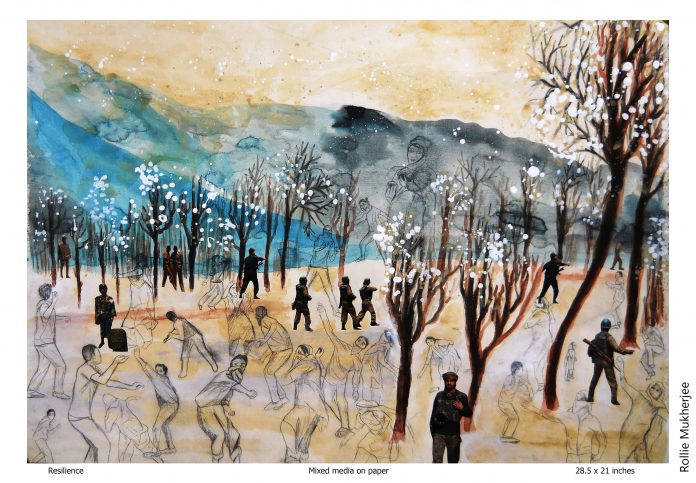By Afreen Firdaus Idrees, Twocircles.net
Rollie Mukherjee, a Vadodara-based artist, was in Kolkata last month as part of the 4th edition of Kolkata People’s Film Festival 2017, showing her artworks on Kashmir titled To Stories Rumoured In Branches at TENT art space, jointly hosted by People’s Film Collective, Tent – Theatre for Experiments in New Technologies, and Conflictorium.
There is something haunting about the viewing experience. Something that wounds us and one must live with it. Something that lingered lit up in my obscurity, till about a month later, I found my musings drifting towards writing about it.

Rollie remembers how her earliest tryst with Kashmiris was when the travelling shawl-wallahs who had journeyed from the Valley to the sleepy town of Jabalpur had a way of turning up at her doorstep with massive cloth bundles lugged on their shoulders to sell an assortment of pherans, kaleens, and embroidered shawls to her mother and be warmly invited for a cup of tea and talk by her father. The snatches of memory of those exchanges that she carried with her, the poignant grief cached in them when they relayed stories of torture and suppression, would reappear in flashes, once she began her own foray into reading – poetry, anecdotes, articles, books – about this lost ‘paradise’ that is Kashmir. This body of writings explored Kashmir beyond its tourist brochure image and deconstructed the negative and harmful representations of Kashmiris and their freedom struggle, Indians surrounded themselves with, especially within the realm of popular culture. Rollie relearned Kashmir as Indian Occupied Kashmir. That is when the journey of To Stories Rumoured In Branches began.
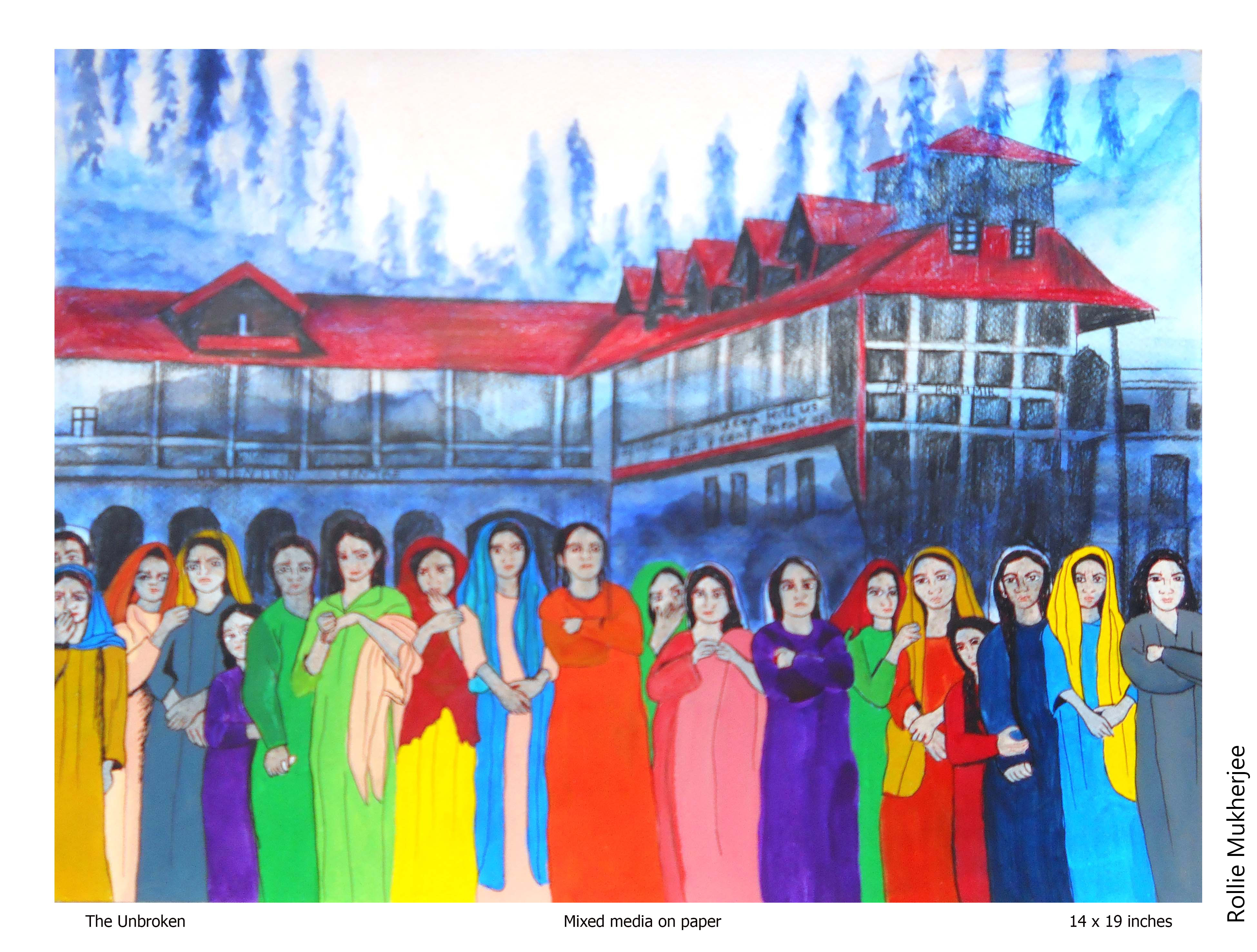
The individual that Rollie Mukherjee is, is in response to painting. She cannot help but paint like this. She could have been lost in wonder of Kashmir’s beauty. It would’ve been the easier thing to do. But she was conscious that if she were to get seduced by Kashmir’s beauty, her art would sit well with the discourse of the oppressive state. Her paintings disseminate fragments of Indian Occupied Kashmir, not of the firdaus on zameen Amir Khusro serenaded: something else, quite so, a synecdoche – snippets of broken bits and belongings – dismembered fragments reminding us of the whole that was lost. Amidst the collected ruins, we recover traces of what cinched these people together into a civilization, a nation, a culture. And one discovers that when we shudder at one of her paintings, it is always surrounding a site which limns rawness, which speaks to us in an idiom which is at once ours and not ours. The semantics of Rollie’s pictorial art is heterodox, an experience which re-etches something.
Religious credo manifests a spirituality rooted in cultural forces and is endemic to the continuum of self-preservation and resistance of Kashmiri people. Kashmiri cultural mnemonics, a collective consciousness of creative knowing, and the emotionally fraught fabric of the Islamic faith has created corridors for resistance. If we are to fathom their struggle against assimilation and annihilation from the Indian Occupation we must evolve an understanding of the spirituality and religiosity – unapologetically Islamic – they cultivate as an apotheosis of resistance. Tarun Bhartiya of Raiot spoke of how “many of the artists’ response to marginal struggles are very human rightist, they never talk of the politics…Rollie’s images are very interesting because they push the Indian liberal consensus on Kashmir, doesn’t stop at the fact of sadness for Kashmiris, it steps out of it, expands it.” Rollie’s works thematize the grief-torn Kashmir Valley, the trauma Kashmiris have endured and continue to endure, and the inescapability of individual and collective memory in this experience. The artist’s graphic impressions along the way of stories create visualizations of pain, desolation, and suffering, testimonies of existence and identity, witnesses of history, instruments of documentation, and a refuge of experiences.
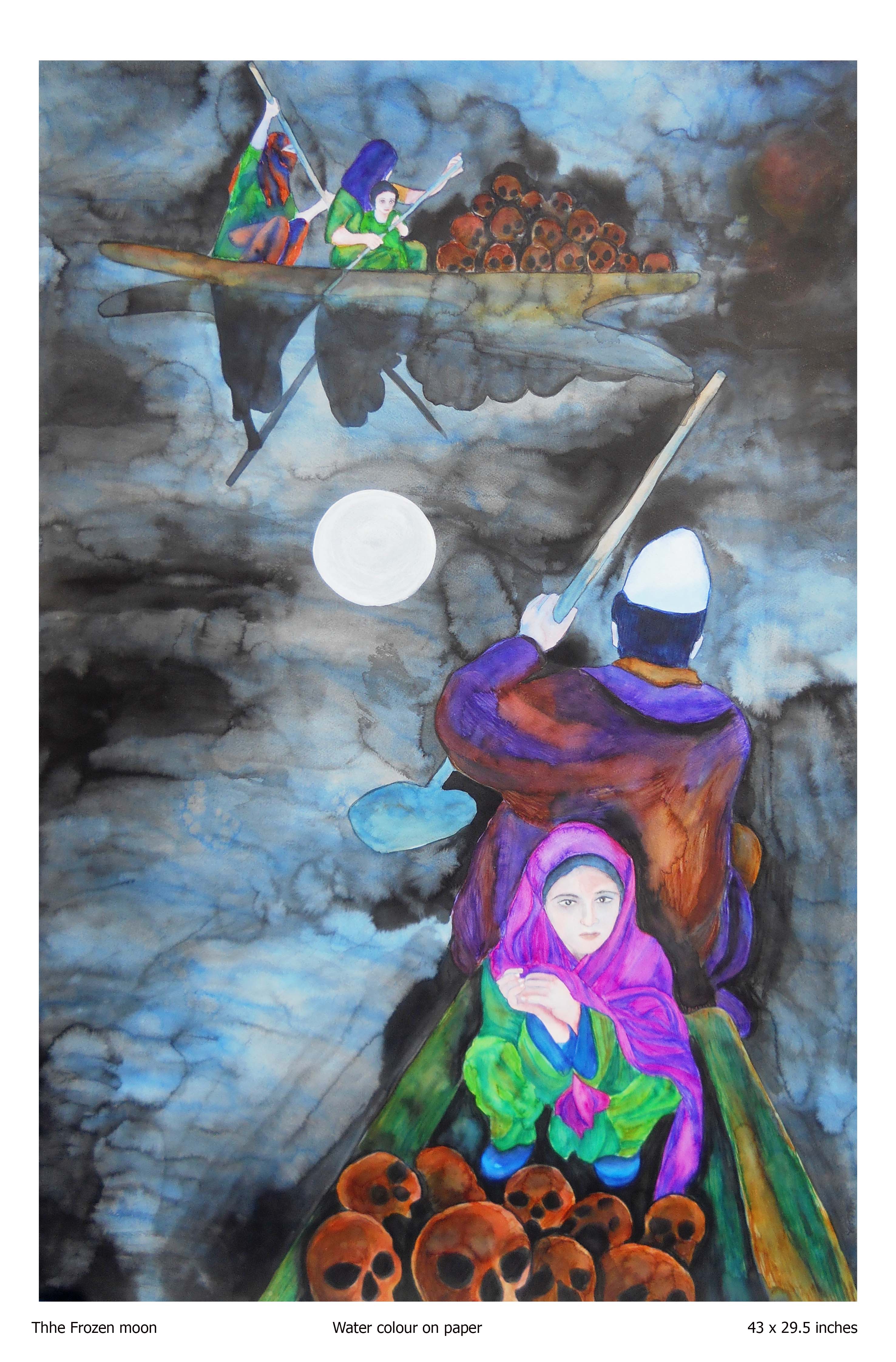
The Frozen Moon could have been lifted from one of Steve McCurry exoticising photographs of Kashmir circulated and consumed widely. Turns out, it is. What Steve McCurry was about was the visual misappropriation of the landscape, erasing out the conflict and its effects on people and society, and aiding perception to indulge and gratify our gaze, socially constructed and aesthetically authorized, as it is, in ways we can savour, or somewhat in ways we see it coming. What Rollie does is to subvert the montage, thereby showing up what the repercussions of such sanitized holiday-making images are for conflict-ridden Kashmir which is its cynosure. Rollie’s painting is a departure in that it is conceived respecting non-tourist embodiment of social experience and consciousness. The scene, as in McCurry’s, is a boatman rowing a shikara in a lake. It is a full moon night. An inversion of Steve McCurry’s photograph lies in that instead of ferrying fresh flowers, they ferry a pile of human skulls, and amidst this debris of craniums left behind by the Occupation, a veiled young girl nonchalantly sits on her haunches, in frozen silence, with her back to the boatman. Drawing on the looming, glazed moon imagery of Paash’s poem ‘Sabse Khatarnaak’ (The Most Dangerous), Rollie says that Kashmiris go about their lives “by rowing through the misery of death of their dear ones…the coldblooded moon silently witnesses the deaths every night”. An analogous work titled Drifting portrays a solitary woman rowing with a stack of skulls in the stillness of winter verglas – a shadowy landscape of death. Also there are floating, brilliant splashes of ornamental Kashmiri patterning veneered over disassembled bones, almost eclipsing them, attempting to supplant the evidence of crimes, and the memory of victims. Rollie’s work is not meant to shroud the scars of conflict, but to unveil the full frame of unseen stories of Kashmiri’s struggle, survival and everyday life.
At the heart of Rollie’s compositions on the survival of history and identity is a traditionally female activity like embroidery. These embroideries are a resolve to go on living, documenting their existence however fragile and endangered it may be. “I have treated the cloth as human body…the wounded body which is the site of pain and is a storehouse of memory – a sedimentation of agony, the site of healing, of hope, despair, love, and loss.” She seeks to embed their memories and temporalities in the materiality of the Kashmiri body, in the Kashmiri women’s bodies that have registered the violent legacies of the Occupation. Unspoken, repressed histories of trauma record itself on the body, not unlike a thick-trunked tree, waiting to be remembered and called out. As long as past traumas and resistances to those traumas live on in the oppressed, occupied body, it can be passed on, as heritage. The body is the repertoire that preserves everything in its flesh; it carries history, and begins to be a site of memory. Recounting, recovering maimed, murdered, and disappeared bodies, manifesting the suffering of the mothers of martyrs, of half-widows, and that of half-mothers as bodily present, and using this gendered, embodied archive to retell an alternative Kashmiri history of the land is a political act. The ‘real’ of official history as told by the Indian state’s hegemonic narratives is not the ‘real’ of the subjective material body. Rollie has used something old and intimate like bedsheets, something that she says “is used very close to the body”, something which becomes an extension of the human body. The fabric embroidery is an attempt to reconstruct and represent the woes of women without effacing the specificity of their local reality. The dyed and tinted threads bind these women, albeit delicately, to the spaces they occupy as their blood and tears bleed into the disembodied body of the fabric, seeping into its symbolic skin. The painful act of suturing through the needles, of threads wordlessly weaving together their long past and their survival, sewing up wounds to urge healing, and leaving behind the scars of incision right on the skin, acts as a foil to the decorative needlework existent on the bedsheet, when it was just that – a bedsheet.
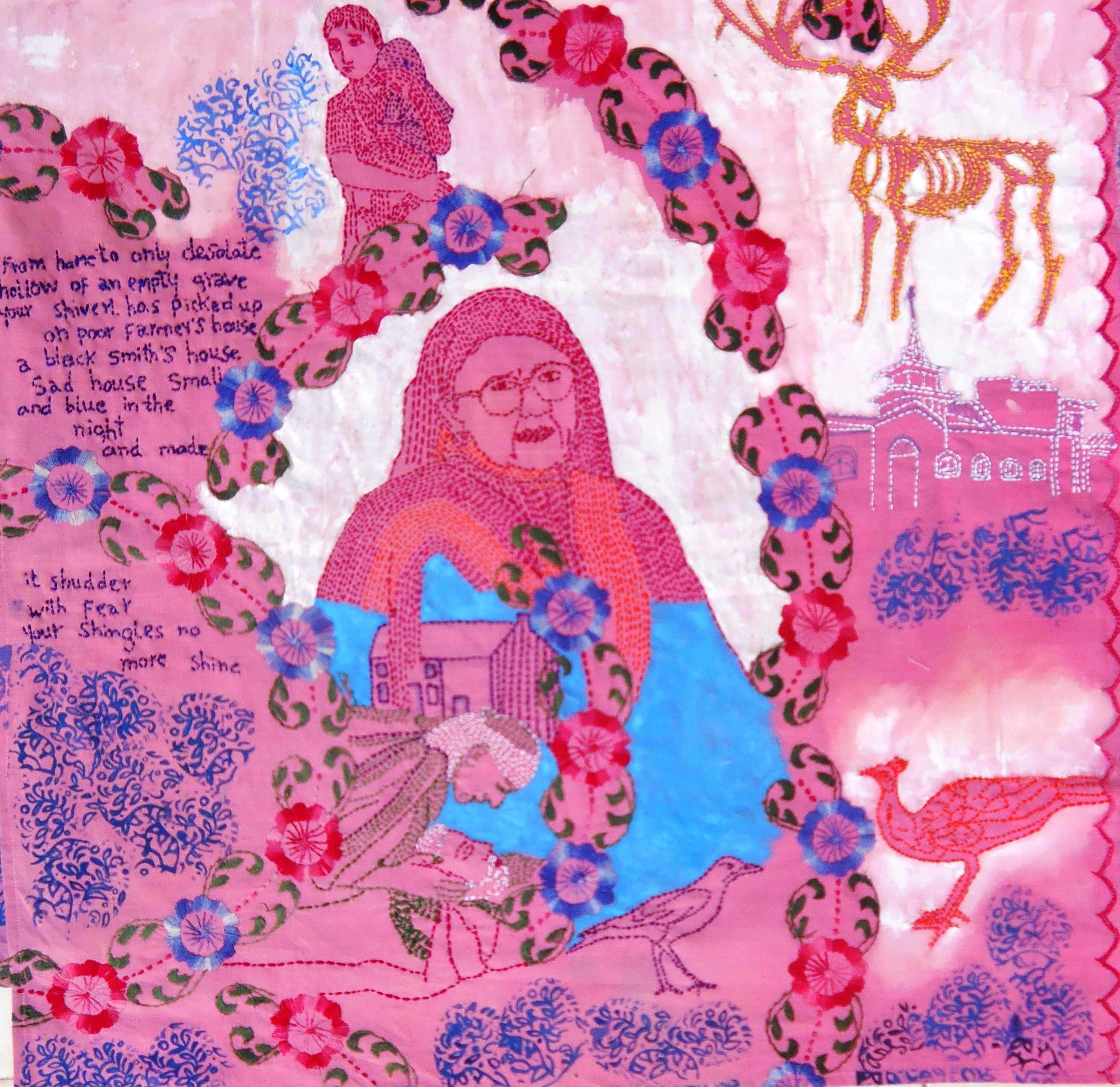
In Specters of Marx: The State of the Debt, the Work of Mourning and the New International, Jacques Derrida notes: “Nothing could be worse for the work of mourning than the confusion of doubt: one has to know who is buried where and it is necessary (to know – to make certain) that, in what remains of him, he remains there, let him stay there and move no more.” The half-mothers and half-widows go about their lives, half-grieving and half-hopeful; the period of mourning is never worked through, and cannot be resolved with time. So, they wait, hope, and yearn. Then there are those martyrs whose bodies do not belong to the mothers and wives who claimed them, those whose remains have been lost, or violated. Without beholding the remains, the desire to bury their loved ones becomes an internalized condition of mourning without end. For them, the grief is unbroken, and the dead go on being encrypted, residing within the grieving body, preserved as evidence. This internal crevasse, where grief is shored up and kept alive in the body, is a void, something Rollie has interpreted in the vast blueness that suffuses the torso of the mother – that which exteriorizes the boundless sorrow resting silently within her hollowed body, vacated and soulless. Martyr Afzal Guru’s aged, broken hearted mother sits melancholic at the centre of the work titled Infinite Sky as she is engulfed by this blankness. There is a small, deserted home near her bosom. Or, perhaps home was in the blood of her son, Afzal, as it flowed through his veins. Falling Threads shows loose end of threads hanging out, as certain wounds that stay open, unforgotten, which resist healing, and fester. Remembering and narrating trauma means, then, delving into open wounds and bodily vulnerability. The unhemmed edges and open threads can undo, with one yank, the very sham of ‘normalcy’ in Kashmir under decades of military Occupation, rip apart the scars and reopen the wounds of a brutal history, the imprint of violence on the skin of the occupied.
Rollie’s work Resilience shows the Kashmiri sangbaaz – men, women, and children – who resist, morally, and protest, ethically against the routinized, normalized genocide that is the Indian Occupation, by taking to the streets, stone in hand, because it is all they have. They voice their own visceral reaction to the irreparable losses they suffer, channeling their rage over the denial of their basic political and civil rights, by breaking through the barriers of fear, defying curfews, risking their lives and clashing their stones with bullets and teargas shells – the visible signs of the military Occupation. There is a dignity to this life of resistance and it is the only life they know. Struggle for azaadi (freedom) is, for them, an ethos. This is the Kashmiri intifada. Rollie has superimposed photographic referents of Indian army personnel in sophisticated body armour to manifest the stark imbalance between armed soldiers, alienated from the land, and unarmed, brave Kashmiri stone-pelting freedom fighters, amorphously rendered in pencil, who fuse into the landscape – the homeland to which they belong.
The works named Shadows Beyond the Ghost Town picture abandoned landscapes that conjure up images of the dead. They reinstate an amorphous aura of dread emanating from the shadows cast by Kalashnikovs and ammunition alongside the shade of the chinar (booen) which dots the autumnal landscape and whose leaves camouflage those mass and unmarked graves where unnamed souls who lived, dreamt, and died, lie buried. It is one vast graveyard sans gravestones. In the ground in which only fractions of bones and bodies rest, there is embedded a foundational element of genocide. Injustice of concealment haunts the scene, not actual spirits. The gun-toting, killer soldiers appear as wayward phantasms, traces, or presences who infest the terrain and leave behind legacies of blank horror. Interestingly, Rollie paints sole female figures who return to inhabit the sites once peopled by the dead and their things, so that the unidentified too receive a place in memory. They look for memory of the lives lost in the rubble of the past. This conscientious struggle to remember calls to mind Allama Iqbal’s couplet: Jis khaak ke zameer me hai aatish-e-chinar, /Mumkin nahi ki sard ho woh khaak-e-arjumand (The dust that carries in its conscience the fire of the Chinar, / It is impossible for that celestial dust to cool down).
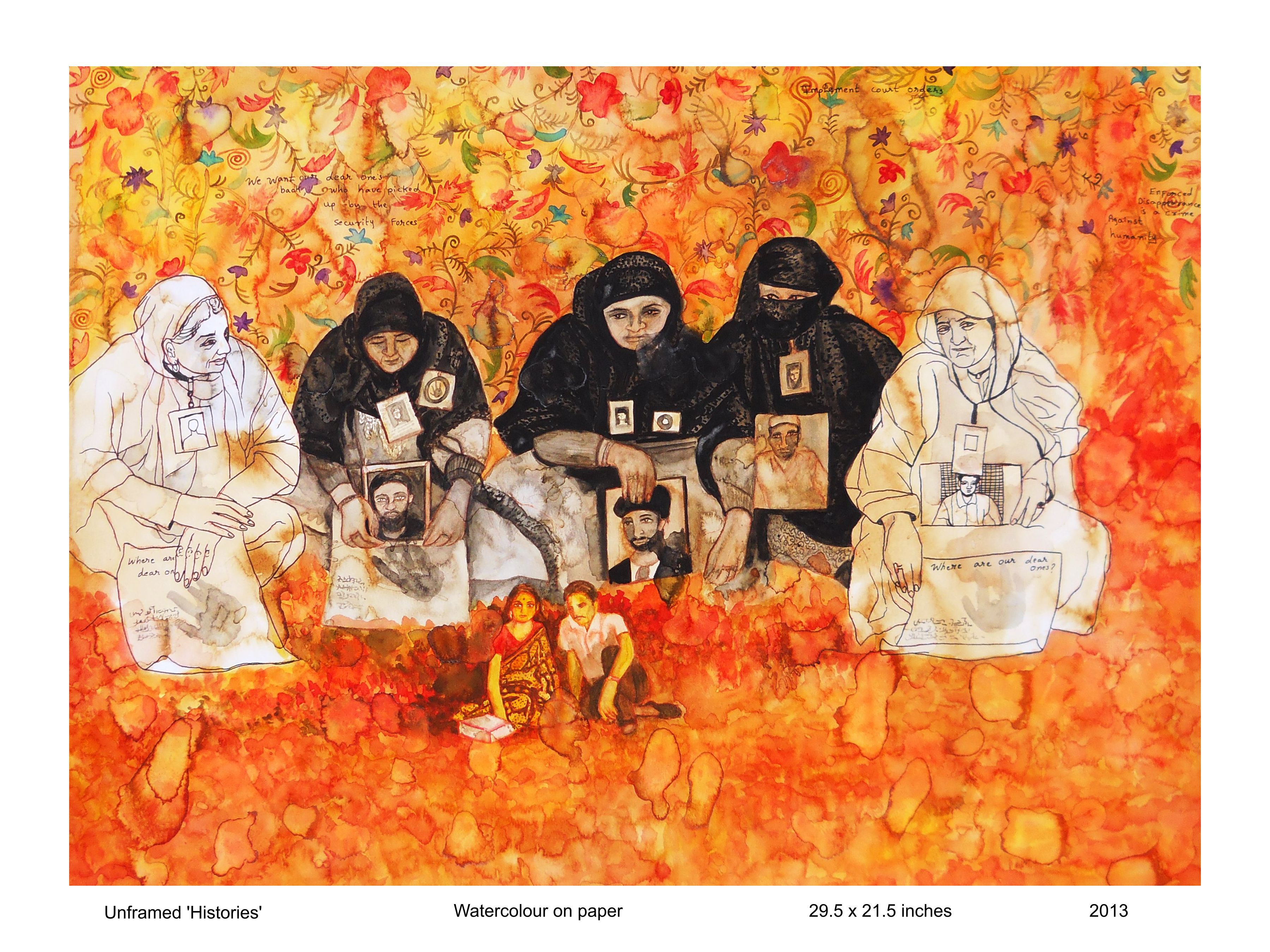
I was drawn back again and again to two haunting images – titled Reflection and The Guesthouse respectively – of refined looking structures in the foothills of the Zabarwan and shuddered at the thought of what went on there. It elicits numbness more than a verbalized indignation. These places of silence communicate by forming a physical attachment with absence, and by giving a voice to absence. These cold, sparse edifices with darkened casements were torture chambers, interrogation cells, execution sites – Hari Niwas and Papa II – where an untold number of innocents were held, destined for death. This was where Kashmiri Muslim men were broken down, subjected to unspeakable horrors by the carte blanche enjoying Indian Army, where their deafening, anguished screams echoed, as life was drained out of them. In Rollie’s rendition of these architectures, there is a choking silence at the desecration of the memory of the lives once animating them, at the attempts at washing away the bloodstains, the unavenged tears, at the control of the memories evoked by the space, and at renovating these sinister facilities into luxurious homes for political stooges of the Indian Occupation.
Scopophilia and sexual voyeurism account for the predominance of the colonizing gaze and its visual tropes. The culturally different, politically Other Kashmiri Muslim woman has come to be reified as exotic and erotic, emptied of female subjective reality, relegated to passivity, and imprisoned in immanence. The pervasive presence of this instrumental vision, of this masculine scopic economy empowers the penetrating Indian gaze to scrutinize, know, and possess. Rollie’s paintings can be perceived as a refusal to unquestioningly reproduce such a representation, as transcending it, as never assuming that Kashmiri women subjects are helpless to negotiate a self-assured speaking and looking position. In The Unbroken, a group of young girls stand close together, hands folded. Their bodies forming a defensive fence as they gaze back at the spectators. Defiant. The walls of what used to be a detention centre cry out the zeitgeist of their resistance: “You can kill us, but you can’t break us!” Then, we see in Ruins of an Utopia and in Unframed ‘Histories’ a Kashmiri woman with a microphone, undermining her supposed muted condition, asserting her autonomous agency, and proceeding to tell her story to the world. Nothing in this Kashmiri woman’s dark and hidden story will die out. It is an unending narrative where even her occupied body speaks, uttering its wounds. In the cognate Unframed ‘Histories’, Rollie contrasts a sepia-tinted photograph crystallizing her honeymooning parents’ joie de vivre with the overpowering image of sorrowful half-mothers protesting their sons’ enforced disappearances with monochrome photographic remnants. In response to the loss and ensuing pain these women have suffered and continue to suffer, there’s a feeling of strength derived from a common fate, rather than a feeling of weakness and humiliation. The visual disharmony between the two vignettes is her auto-critique of her own generational privileges as well as a search to learn another suppressed memory – a feared memory that will not ebb. Her paintings are active political texts emerging at the interstices of this scopic economy and bearing witness to the reorganization of the sensorium, and the new kinds of knowledge and viewing that it opens up, daring us to look and see differently.
In the watercolour Mourning, Rollie has poignantly chronicled the agonizing janaza of the Shaheed/martyrs – militants and civilians, alike. The political climate in Kashmir being what it is, funerals are as much about mourning the slain, as they are about a modality of protest. Thousands of people, whole villages, defy curfew and put their lives on the line, to take turns to carry the martyred bodies on their shoulders, chanting “aye shaheedo as salaam” amidst tears and raised fists, or try to catch a glimpse or caress the faces of their beloved martyrs, whose bodies are thoughtfully kept warm in blankets on their chilling journeys, one last time, before the promised heavens open to take them in. Rollie’s reframing vision restoring dignity to the being of the martyred rebels as against the hyper-visible images of violence-saturated Kashmiri militant bodies, projects a counter sight and visibility that denaturalizes the masculinist, optically calibrated visual culture of death brazenly made available by the Occupation. Rollie’s contextualizing of the visual realities of the evocative funeral spectacles of those freedom fighters whom the Indian Army takes out as always already ‘terrorists’, opens up a window for critical reflection incumbent on Indians to question not just their own blindness but also the entrenched discursive vocabulary on a Kashmir and its dead that they might know little about.
The occupied body has an indelible memory: it is in the air it breathes. It remembers. That is where resistance begins. Keeping alive the memories of the growing evermore count of the murdered, the disappeared, and the tortured, recollecting their names, cries out for a conscionable response: No more and never again. Memory – our capacity to remember – is both the nemesis of smug complacency and the premise for solidarity, bridging us past time and miles to those who remember also. Rollie with her paintbrush became a witness with a choice: to disremember or to remember. She chose to paint. Against disremembering.
The author has completed M.Phil in Social sciences at Centre for Studies in Social Sciences, Kolkata.

